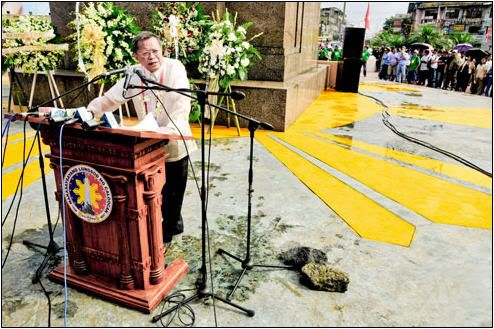Update 53 - Duque Orders DOH to Bolster Mitigation Efforts Against A (H1N1)
01 July 2009
Health Secretary Francisco T. Duque III today reported that the Department of Health (DOH) is further bolstering its mitigation efforts against Influenza A(H1N1) in light of the anticipated rise of cases in the country.
On June 30, Duque convened another DOH Command Conference attended by members of the A (H1N1) Task Force, the DOH regional health directors, the chiefs of hospitals of all the 72 DOH-retained hospitals in the country, and some representatives from the private sector.
“As we anticipate more cases in the coming months, we must institute effective mitigation measures to save lives and prevent deaths and to reduce the impact of the pandemic to our nation and the economy,” Duque said.
With the shift toward the mitigation strategy, the DOH is ensuring that all government hospitals, both at the national and local government levels have the capacity to administer care to high-risk patients where the severe manifestations of the A (H1N1) virus are frequently seen. This is in accordance with the directives of President Gloria-Macapagal Arroyo last week to prepare well-equipped isolation wards in all state-run hospitals throughout the country.
High risk patients include patients with preexisting medical conditions such as asthma, diabetes, cardiovascular disease, immunosuppression, HIV/AIDs, TB, pregnant women and the very young and the elderly.
Duque also called for a meeting with the member agencies of the National Disaster Coordinating Council (NDCC) to engage them, particularly the DILG, in strengthening the involvement of local government units in the A (H1N1) response. This is to make sure that local governments have surveillance, monitoring and response systems in place and that hospitals and primary health care facilities under their jurisdiction are able to identify, treat and manage A (H1N1) cases.
“We have also requested the NDCC member agencies, especially DepEd, CHED and TESDA and PIA to help us in our nationwide campaign against A (H1N1). This is to make sure that our information and education activities reach all schools, barangays and provinces in the country,” Duque added.
Come next week, DOH is also set to meet with the Philippine Medical Association (PMA) and hospital groups like the Philippine Hospital Association (PHA) and the Philippine Hospital Infection Control Society (PHICS) to engage all hospitals and healthcare providers in the appropriate treatment and management of A (H1N1) patients according to the set interim guidelines of the DOH.
Meanwhile, Duque announced that 1,709 confirmed A (H1N1) cases have been reported to the DOH from the 1st week of May up to June 27, 2009. Eighty-six percent (86%) or 1,485 of these cases have already recovered, while the remaining 224 (14%) are still under treatment at present, most of them under home management.
“All cases exhibited mild symptoms with the most common as fever (86%), cough (81%), and nasal congestion (49%),” Duque said, noting however, that there was one reported death.
“The ages of cases range from 5 months to 79 years old, with 18 years old as median age. Most of them belonged to the 10-19 years age group (831 or 49%). Majority of the cases were male (894 or 52%),” Duque described.
Duque disclosed that of the 1,709 reported cases, 1,568 (92%) were Filipinos; the rest were American (with 17), Japanese (8), Chine (4), Korean (3), German (2), and one each from Australia, Canada, India, Iran, Kyrgyzstan, Lebanon, Sweden, Thailand, and Turkey.
“Two hundred and eighty-five cases (17%) had history of travel to a country which has reported A (H1N1) cases. Most came from the USA, China, Japan and Singapore,” Duque noted.
Duque said that as far as the geographic profile of the 1,709 cases is concerned the National Capital Region has the most number of patients: comprising 72% (1,225). Cases from NCR mostly came from Quezon City, Manila, Parañaque, Pasig and Makati.
The three other regions that reported the most number of cases were: Regions IV-A, III and VIII.
As far as the global report is concerned, the World Health Organization, as of June 29, has recorded 70,893 cases with 311 deaths from 109 reporting countries.
GOD BLESS YOU PRESIDENT CORY!
Wednesday, July 1, 2009
July 1, 2009 - 1,709 Confirmed H1N1 Cases Announced at TV Patrol; The 1,709 Figure is Actually as of June 27, 2009 According to DOH Website
1 July 2009
TV Patrol anchors Karen Davila and Ted Failon announced that the Philippines now has 1,709 confirmed cases of the H1N1 flu virus.
For technical accuracy, however, the number of confirmed H1N1 cases of 1,709 is as of June 27, 2009.
The DOH should do all it can to update the figures and post the necessary information daily on its website.
Subscribe to:
Post Comments (Atom)
















No comments:
Post a Comment
If you encounter any problem posting your comment, such as the error message "Your request could not be processed. Please try again," the problem might be resolved simply by trying to resubmit the comment. Otherwise, please email me at rollyocampo@yahoo.com. Thanks a lot for visiting my blog. Have a nice day and God bless!